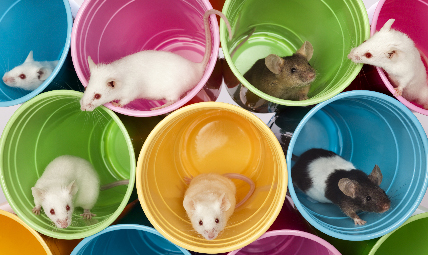Technology developed at the University of Cambridge is transforming the way cognitive tests are performed on animals, leading to more directed experiments and ultimately aiding development of new drugs to treat schizophrenia and other neurocognitive disorders.
Professor Tim Bussey and Professor Lisa Saksida of the Department of Psychology have established a series of targeted cognition tests for animals, administered via touchscreen within a custom environment, known as the ‘Bussey-Saksida touchscreen chamber.’ A major inspiration for the touchscreen approach was a suite of tasks originally designed for humans and primates called CANTAB. Each individual task is aimed at pinpointing and then testing one particular aspect of cognitive function. Bussey and Saksida took this model and adapted it to test small rodents using almost identical methods.
The Bussey-Saksida chamber – affectionately known within Cambridge Enterprise as the ‘mouse cube’ – allows for new and improved ways of evaluating attributes associated with schizophrenia and other neurocognitive disorders in rats and mice. It allows researchers to test memory, attention and problem-solving ability in a fully automated environment. The touchscreen method employed in the chamber is the same as that used to test humans, and some of the tasks are identical, facilitating the translation of animal studies to a clinical environment.
The space inside the Bussey-Saksida chamber has been adapted to optimise the speed at which the tests are undertaken, and has a unique trapezoidal wall shape to focus the animal’s attention and encourage the tests to be completed more quickly. Additionally, the tests are reward-based, which often give better results than aversive testing.
The Bussey-Saksida chamber – affectionately known within Cambridge Enterprise as the ‘mouse cube’ – allows for new and improved ways of evaluating attributes associated with schizophrenia and other neurocognitive disorders in rats and mice.
The tests use high-contrast images, tailored to a mouse’s eyesight. The mouse views a display on a computer screen and chooses either an object or a location on the screen; instead of pressing a lever or poking its nose into a hole – as is the case with many other mouse cognition tests – the mouse responds directly to the touch-sensitive screen via a nose-poke to receive a food reward (strawberry milkshake is the current favourite. Really.)
The tests span many aspects of cognition and behaviour, including learning, memory, attention, problem-solving and motivation. The mice can be put through a range of tests to see, for example, how the absence or presence of specific genes affects these aspects. The researchers can then take the results from a range of mice with different genes in order to form a cognitive profile. Cambridge Enterprise, the technology transfer office of the University, supported commercialisation of the Bussey-Saksida chamber, culminating in a licence to Loughborough-based Campden Instruments in 2008, and a series of new tasks to the company in 2009. Bussey and Saksida continue to develop and licence new tasks for use in the system. Campden worked with the inventors and the Life Sciences team at CE to refine the chamber before launching it as a commercial product.
Campden Instruments were heavily involved in the development of the product, creating high sensitivity touchscreens specifically for mice and designing the accompanying ‘ABET II Touch’ software. They established the ‘CamTouch Standard’, developing the vital experimental parameters as a standard for worldwide adoption of this work in other laboratories (including the size and format of the images, the screen and its sensitivity.) They incorporated the use of the ‘Whisker’ multimedia server, developed by Cardinal and Aitken and also licensed from Cambridge, which was already being used in their primate CANTAB product. Campden also developed electromagnetic shielding and compatibility for electrophysiology recordings in the chambers, and included an infrared camera and video recorder.
Campden Instruments contributed to the proliferation of the science by organising touchscreen seminars at the Society for Neuroscience meeting, and supporting a symposium. They also developed the ‘Easi-Install’ system, enabling the product to be delivered worldwide.




